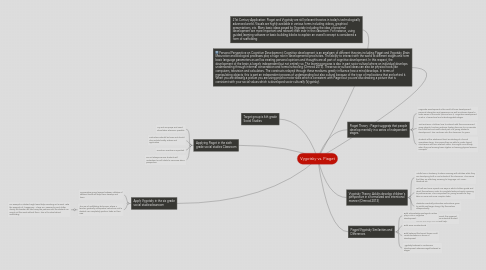Vygotsky vs. Piaget
Door David R Saroea

1. Personal Perspective on Cognitive Development :Cognitive development is an amalgam of different theories including Piaget and Vygotsky. Brain Maturation and biological processes play a huge role in developmental proclivities. The ability to interact with the world at different stages and form basic language parameters as well as creating personal opinions and thoughts are all part of cognitive development. In this respect, the development of the brain is largely independent but not entirely so. The learning process is also in part socio-cultural where an individual develops understanding through informal conversation and formal schooling (Ormrod 2013). These socio-cultural ideas can also be physical tools like computers, television and calculators. The constructs relayed through these mediums greatly influence how a mind develops. In terms of manipulating objects, this is part an independent process of understanding but also cultural because of the type of implications that are behind it. When you are drawing a picture you are using psycho motor skills which is consistent with Piaget but you are also drawing a picture that is consistent with your social values which is developed socio-culturally (Vygotsky).
2. Applying Piaget in the sixth grade social studies Classroom
2.1. Try and use props and visual stimulation whenever possible
2.2. Instructions should be terse and should also include bodily actions and application
2.3. Hands on Practice is important
2.4. Do not always assume students will understand or will relate to someone else's perspective
3. Apply Vygotsky in the six grade social studiesclassroom
3.1. Cooperative group lessons between children of different levels will help them develop and learn.
3.2. The use of scaffolding technique: where a teacher gradually relinquishes instruction until a student can completely perform tasks on their own.
3.2.1. For example a student might need help sounding out a word. Take the example of "hegemony." There are pennies for each letter. Slowly the teacher will take away the pennies until the student can sound out the word without them. This is the idea behind scaffolding.
4. 21st Century Application: Piaget and Vygotsky are still relevant theories in today's technologically advanced world. Visuals are highly available in various forms including videos, graphical presentations, etc. Many basic ideas posed by Vygotsky including the idea of proximal development are more important and relevant then ever in the classroom. For instance, using guided learning software or basic building blocks to explain an overall concept is considered a form of scaffolding
5. Target group is 6th grade Social Studies
6. Piaget Theory : Piaget suggests that people develop mentally in a series of independent stages.
6.1. Cognivite Development is the result of brain development, personal interaction and experience as well as intrinsic desire to make sense of the world (Ormrod 2013). Cognitive Development is set in 4 hierarchical and interchangeable stages.
6.2. Trial-and-Error: Children love to interact with their environment using objects, touching surfaces, feeling faces so it is no wonder this is the first and most critical part of a young student's development. This continues into the classroom for years.
6.3. Students at the adolescent level are dealing at a formal operations stage. This means they are able to create logical conclusions and form abstract ideas. This might come handy when they are learning basic algebra or learning physical science concepts.
7. Vygotsky Theory: Adults develop children's perspective in a formalized and intentional manner (Ormrod 2013)
7.1. Adults have a tendency to share meaning with children while they are developing both in and outside of the classroom. This means that they are attaching meaning to language, art, music, literature etc.
7.2. Self Talk and Inner Speech are ways in which children guide and direct themselves in order to complete tasks and apply meaning to performances. This is important for young learners as they take on more and more complex tasks.
7.3. Students eventually internalize instructions given by adults and begin doing it by themselves independently.
7.4. Zone of Proximal Development: the apparent difference between what an individual student can do with help and without help.
8. Piaget/Vygotsky Similarities and Differences
8.1. Both acknowledge Biological Factors play a role in cognitive development.
8.2. Both were constructivists
8.3. Both believed that social forces could create limitations in terms of development
8.4. Vygotsky believed in continuous development whereas Piaget believed in stages


